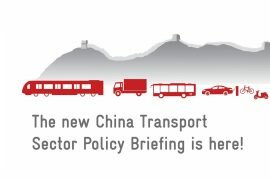
Interview with Dr. Wu Yue.
Dr. Wu Yue is the chief engineer of the intelligent transport division at the Shenzhen Urban Transport Planning Center (SUTPC). Dr. Wu Yue received his PhD from Tongji University in Shanghai in 1990. Before joining SUTPC 3 years ago, he had been working in Singapore as an intelligent transport engineer.
GIZ:How would you describe your role and duties as chief engineer of SUTPC`s intelligence department?
Dr. Wu: Generally, I am working as the technology director to guide the research directions of intelligent transport business (ITS), the adviser of important intelligent transport projects of the company, and also developing the partnership with cooperation in ITS supply chain.
GIZ:You were working in Singapore in transport planning for more than a decade. What experiences from Singapore would you want to apply in Shenzhen?
Dr. Wu: Singapore is an island of 4.8 million people with limited space. Sustainable transport is key to its development. Shenzhen is quite similar to Singapore in many aspects. I think Shenzhen should learn integrated transport planning, the environment friendly transport policy and dedicated transport infrastructure design from Singapore.

GIZ: What do you see as the main goal for Chinese cities when planning their transportation infrastructure and transportation management?
Dr. Wu: Nowadays, China pays great attention to the sustainable development, environmental protection. We are trying to minimize urban environmental impact, promote a low-carbon emission urbanization, and build a more open, accessible, equitable, environment-friendly, and safe transportation system.

GIZ: Where do you see the main challenges for Chinese cities to create more livable cities and low-carbon transportation?
Dr. Wu: With the rapid development of economy, there are still many challenges, including an aging population, rapid urbanization, environmental impact, etc.

GIZ: Where do you see the biggest potentials and the biggest risks when using big data for traffic planning?
Dr. Wu: On the one hand, with big data, large-scale manual surveys are sometimes not necessary any more, while data mining can provide information that we used to be unaware of. We use data fusion and data mining models to find knowledge in big data to optimize the transportation system planning and management.

On the other hand, we are still in the beginning stage of using big data. The biggest risks will be the quality and reliability of the big data, as well as the research results.
GIZ: What future technologies do you think will have major impacts on transportation and how do you plan to manage it?
Dr. Wu: Autonomous vehicle, AI (Artificial Intelligence) and IoT (internet of things) are the technologies in the future that will change our transportation system. We should be prepared in advance. We are planning the test ground for these new technologies in Shenzhen now.
GIZ: Can you describe your experiences working with GIZ?
Dr. Wu: We have been working with GIZ on traffic emission modeling in Shenzhen, and thanks GIZ for sharing the knowledge and experience in Europe. For sustainable development, we shared the same value and vision with GIZ. I believe that we will have more opportunities to work together.

GIZ: What are your next goals as chief engineer at SUTPC?
Dr. Wu: I will work with my colleagues to provide more advanced ITS solutions in China, and share with the world. For the next step, we aim at expanding our services to overseas cities.
About Shenzhen Urban Transport Planning Center (SUTPC)

The Shenzhen Urban Transport Planning Center (SUTPC) was established in 1996 as a national high-tech enterprise in the field of urban traffic research. Based in Shenzhen, the 800 employees of SUTPC (60% of which have master degrees or PhDs) provide urban transport solution services to 29 provinces and more than 100 cities in Mainland China, Hong Kong, and Macao. SUTPC explores ways to make smart and liveable cities as well as sustainable urban development a reality by focusing on the most advanced transportation technologies and services. SUTPC analyzes more than 750 million records of data daily to provide integrated solutions and the most advanced services and products for government, enterprises and the public. With its work, SUTPC has already helped to advance mobility for over 200 million people.
SUTPC cooperation with GIZ
Since 2012, under the support of German Federal Ministry of Environment and Shenzhen municipal government, GIZ has been collaborating with SUPTC to develop a sustainable low carbon transport systems. Areas of cooperation include
- the first realtime transport emission monitoring platform in China that employs an internationally recognized evaluation methodology,
- smart on-street parking management with cashless payment systems, and
- the annual big data conference focusing on the future technologies to transform transportation systems.




